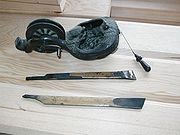
Chalk line
Encyclopedia

Straightedge
A straightedge is a tool with an edge free from curves, or straight, used for transcribing straight lines, or checking the straightness of lines...
.
It is an important tool in construction
Construction
In the fields of architecture and civil engineering, construction is a process that consists of the building or assembling of infrastructure. Far from being a single activity, large scale construction is a feat of human multitasking...
and carpentry
Carpentry
A carpenter is a skilled craftsperson who works with timber to construct, install and maintain buildings, furniture, and other objects. The work, known as carpentry, may involve manual labor and work outdoors....
, the working of timber in a rough and unplaned state, as it does not require the timber to have a straight or squared edge formed onto it beforehand.
History

Chalk
Chalk is a soft, white, porous sedimentary rock, a form of limestone composed of the mineral calcite. Calcite is calcium carbonate or CaCO3. It forms under reasonably deep marine conditions from the gradual accumulation of minute calcite plates shed from micro-organisms called coccolithophores....
lines have been in use since ancient Egypt, and used continuously by builders in various cultures since.
Continuing development of this simple but effective tool focuses on the coloration for the chalk or marking compound, as well as the outer case and method of handling.
Use
A chalk line draws straight lines by the action of a taut nylonNylon
Nylon is a generic designation for a family of synthetic polymers known generically as polyamides, first produced on February 28, 1935, by Wallace Carothers at DuPont's research facility at the DuPont Experimental Station...
or similar string
Twine
Twine is a light string or strong thread composed of two or more smaller strands or yarns twisted together. More generally, the term can be applied to any thin cord....
. Specifically, the string (previously impregnated or coated with a loose dye such as chalk) is laid across the surface to be marked and pulled tight. The string is then plucked
Plucking
Pluck or plucking may refer to:*Plucking , the removal of hair, fur, or feathers*Feather-plucking, a behavior in birds*Plucking post as used by birds of prey to dismember their prey*Plucking , a process related to glaciers...
or snapped sharply to cause the string to strike the surface, leaving a straight line. The primary problems associated with improper maintenance of a chalk line are string breakage due to excessive tension on the line, and degradation of the line associated with moisture contamination.
Chalk lines and plumb-bob
Plumb-bob
A plumb-bob or a plummet is a weight, usually with a pointed tip on the bottom, that is suspended from a string and used as a vertical reference line, or plumb-line....
s are often sold as a single tool.
Ink lines

On the completion of a major building, such as a temple, a large celebration or topping-out ceremony
Topping out
In building construction, topping out is a ceremony held when the last beam is placed at the top of a building. The term may also refer to the overall completion of the building's structure, or an intermediate point, such as when the roof is dried in...
is held. As part of this event, a set of symbolic carpenter's tools are freshly made and presented to the new building. A sumitsubo is a traditional tool included with them.

